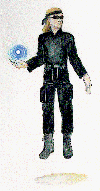Colors ExplainedPart Two: The Basic OutlineWhen the system was ready and I sat down to think about the project that would eventually become Colors, it turned out that simulating superhuman powers in a live-action setting was actually not going to be my main obstacle. No, the biggest problem would be the scenario. I didn't just want to recreate live-action cliches in a different guise, but create a superhero story that could also be told in media other than LARP. The easiest way to write a live-action scenario is to put everything but the kitchen sink in it: to write the characters so that everybody is scheming against everybody else and nothing is as it seems, to put in a representative from every possible faction, to make sure that all the weird things that just might happen actually do, thus making sure that nobody gets bored and incidentally, that no one has a clue as to what is actually going on. Sometimes this is fun, but I find that it leads to games that are very messy, infinitely confusing and often very hard to take seriously. In addition, it doesn't sound like superheroes at all. Therefore I opted for a storyline that was very simple and straightforward. One team of heroes has just had a very hairy but inconclusive battle with its arch-enemy. Running away they meet another hero group, and manage to convince them to take them to a safe place where they can tend to their wounded. As these two factions who have no particular reason to trust each other try to get along, the arch-enemy of team number one also gathers his forces, locates his foes, and goes in to have a rematch, not particularily caring that his opponents might now have allies. That was all there would be no traitors in any of the teams, no alien observers, no strange coincidences. Decent basic idea now to fill in all the gaps. Previous: The Mechanics * Back to Contents * Next: The Storyline
|
